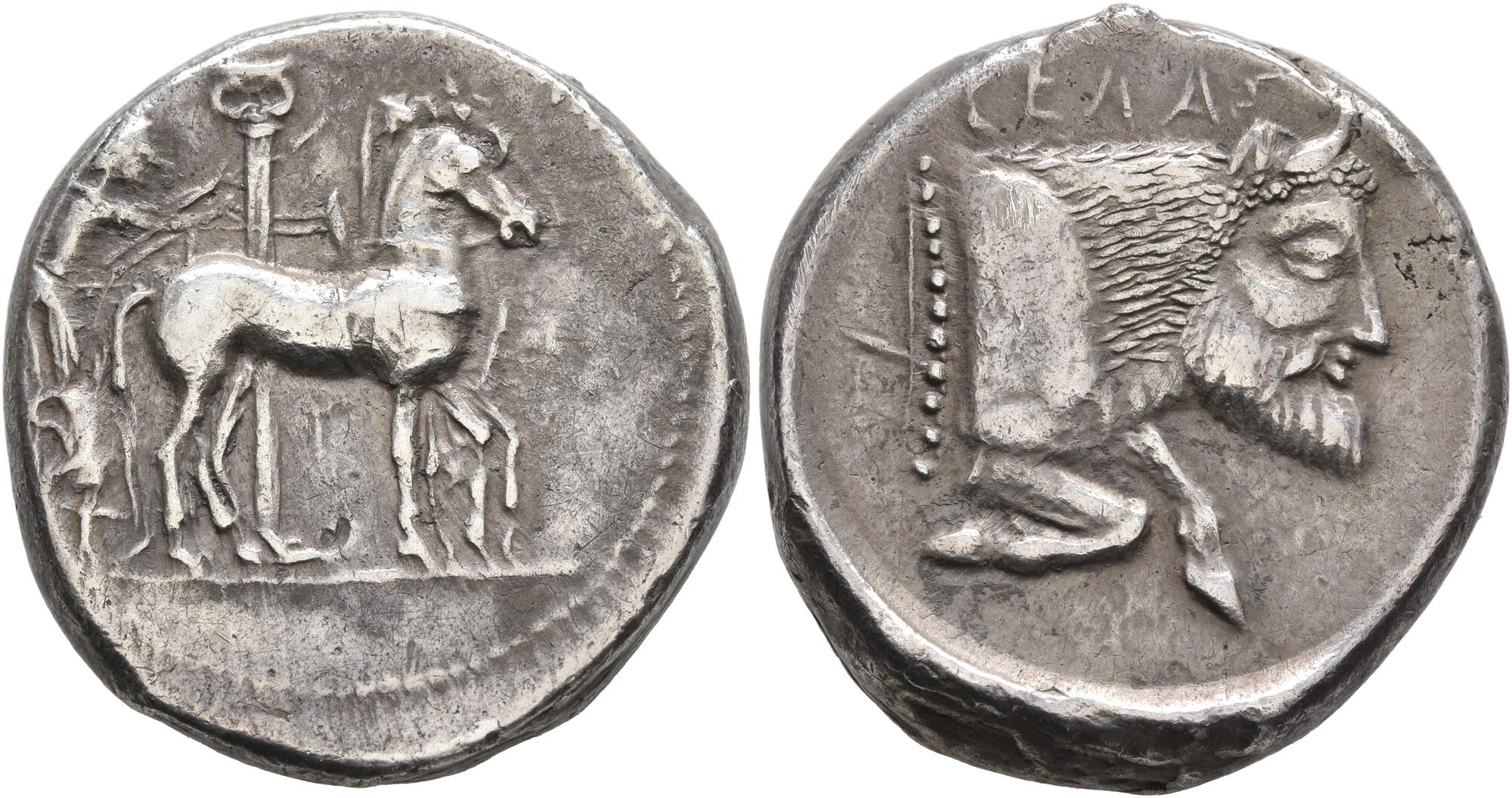AC 46 - Gela, silver, tetradrachms (465-450 BCE)
From SILVER
465 BCE - 450 BCE Silver 4,861 kg
Description
| ObverseInscription or printing placed on the obverse.: | Charioteer, holding reins in his right hand and kentron in his left, driving slow quadriga to right, in background, column with Ionic capital set on plinth of two steps. |
| ReverseInscription or printing placed on the reverse.: | CEΛAΣ (Greek).Forepart of man-headed bull right |
Mint and issuing power
| MintIdentifies the place of manufacture or issue of a numismatic object.: | Gela | Ancient regionAncient region.: | Sicily | Modern countryModern country: Italy | AuthorityIdentifies the issuing power. The authority can be "pretended" when the name or the portrait of X is on the coin but he/she was not the issuing power. It can also be "uncertain" when there is no mention of X on the coin but he/she was the issuing power according to the historical sources: |
Chronology
| FromIdentifies the initial date in a range assigned in a numismatic context. | 465 BCE | toIdentifies the final date in a range assigned in a numismatic context.. | 450 BCE | PeriodTime period of the numismatic object.: Classical 480-323 BC |
Physical description
| MetalThe physical material (usually metal) from which an object is made.: | Silver |
Median weightMedian of the weights of numismatic objects (in grams). in grams | 17.25 | DenominationTerm indicating the value of a numismatic object. Examples: tetradrachm, chalkous, denarius.: | tetradrachm |
StandardStandard.: | Attic |
Image

AC 46 - Gela, silver, tetradrachm, 465-450 BC.jpg [1]
References
| Die study referencePublication of the study: | Jenkins 19701Jenkins 1970, p. 220-228, n° 203-214 (Group III) | ||
| Coin series referenceReference to coin series study: | Sear I2Sear I, n° 789-790, RQEMAC3RQEMAC, n° 46, HGC 24HGC 2, n° 339 | ||
| Coin series web referenceCoin series web references: | |||
Obverse dies distribution
| FrequencyFrequency of specimen in distribution. ᵖ | Number of obversesNumber of obverse dies. ᵖ (o) | % (o) | Number of coinsNumber of coins. (n) | % (n) | Die nameName(s) of the die(s). |
| 1 | 1 | 7.14 | 1 | 0.64 | 53 |
| 4 | 3 | 21.43 | 12 | 7.64 | 55, 59, 63 |
| 7 | 1 | 7.14 | 7 | 4.46 | 54 |
| 8 | 1 | 7.14 | 8 | 5.1 | 52 |
| 11 | 1 | 7.14 | 11 | 7.01 | 64 |
| 12 | 1 | 7.14 | 12 | 7.64 | 65 |
| 14 | 1 | 7.14 | 14 | 8.92 | 58 |
| 16 | 1 | 7.14 | 16 | 10.19 | 62 |
| 17 | 2 | 14.29 | 34 | 21.66 | 56, 6 |
| 20 | 1 | 7.14 | 20 | 12.74 | 57 |
| 22 | 1 | 7.14 | 22 | 14.01 | 61 |
| Total | 14 of 14 | 99.98 | 157 of 157 | 100.01 |
Reverse dies distribution
no distribution is available
Quantification
| Number of obversesNumber of obverse dies. ᵖ (o) | 14 | Number of singletons (o1)The number of singleton coins. ᵖ | 1 |
| Number of reverse diesNumber of reverse dies. (r) | 21 | Number of coinsNumber of coins. (n) | 157 |
| Coins per obverse dieNumber of coins per obverse die. (n/o) | 11.21 | Coins per reverse dieNumber of coins per reverse die. (n/r) | 7.48 |
| Reverse per obverse ratioRatio of obverse dies divided by reverse dies. (r/o) | 1.5 | Percentage of singletons (o1)number of coins (n) divided by the number of singletons (o1) ᵖ | 7.14 % |
| Original number of dies (O) (Carter 1983 formula)The estimation of the number of coins according to Carter 1983 ᵖ | 14.09 | Coins struck if 20,000 as average productivity per dieCoins made if the average productivity for obverses (according to Carter) is 20,000. ᵖ | 281,800 |
| Original number of dies (O) (Esty 2011 formula)The estimation of the number of coins according to the singleton formula in Esty 2011 ᵖ (O) | 15.37 | Survival rate if 20,000 as average productivity per dieSurvival rate if average productivity is 20,000. ᵖ | 0.00056 |
| Coverage (o = % of O) (Esty 1984 formula)Esty 1984 - coverage (% of O) ᵖ (o = % of O) | 99.36% | Die productivity if survival rate 1/2,000Average productivity if survival rate is 1/2,000. ᵖ | 22,285.31 |
| Weight of silver (in kg) if 20,000 coins per die (O = Carter formula)Carter 1983 * Median weight * 20000 (*10 if gold or electrum) ᵖ | 4,861 kg <br /> 4,861 kg | Die productivity if survival rate 1/5,000Average productivity if survival rate is 1/5,000. ᵖ | 55,713.27 |
Remarks
Most likely more than 2 workstations